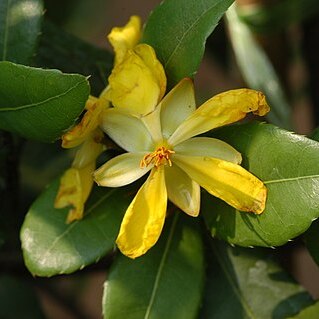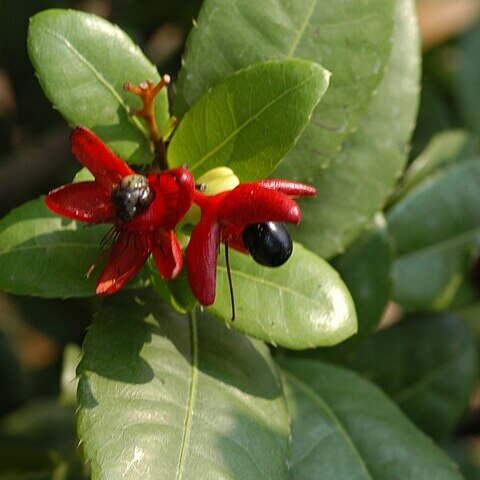Leaves petiolate; lamina (5) 6·5–11·2 × 2·6–5·1 cm. (up to 21 × 7 cm. in E. Africa), elliptic or oblong-elliptic to narrowly obovate, obtuse to rounded and mucronate at the apex, with margin entire or slightly undulate, usually beset with numerous equal dark-tipped cilia, cuneate to cordate at the base, ± coriaceous, with main lateral nerves more prominent than subsidiary ones and densely reticulate tertiary venation prominent above but almost plane below; petiole 4–5 (6) mm. long, slender to stoutish, sometimes rather swollen.
Shrub or small tree (1) 2–5 (6) m. high, evergreen, with bark rather rough, greyish-white; branches slender or rather stout, ± spreading, reddish-purple or brownish with prominent lenticels at first, becoming greyish-white.
Flowers 3-c.20 in ± condensed panicles terminating short lateral shoots; pedicels 1–2·5 cm. long in fruit, articulated about 1/4 the distance from the base.
Sepals 10–14 mm. long in flower, elliptic to elliptic-oblong, rounded, becoming red, 12–16 mm. long, flat and spreading in fruit.
Stamens with anthers 4–5 mm. long, equalling or half as long as the filaments, frequently incurved, dehiscing by apical pores.
Petals bright yellow, sometimes dark-veined, 15–25 × 10–18 mm., obovate to broadly elliptic, unguiculate.
Drupelets 9–10 × 5·5–8 mm., flattened-cylindric, inserted near the base; embryo straight.
Carpels (8) 10–12, with styles free at the apex and spreading; stigmas capitate.


